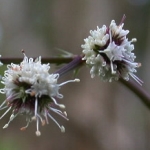| Common Name: |
Sanicle |
| Botanical Name: |
Sanicula europaea |
| Genus: |
Sanicula |
| Family: |
Apiaceae |
| Native Location: |
Europe |
| Cultivation: |
Moist, well-drained, rich soil in shade or partial shade. |
| Propagation: |
By seed sown when ripe; by division in autumn or spring. |
| Harvest: |
Whole plants are picked while they are flowering so they can be made into infusions and liquid extract. |
| Height: |
60cm (24in) |
| Width: |
15-30cm (6-12in) |
| Hardiness: |
Z3-8 |
| Parts Used: |
Whole plant |
| Properties: |
A cleansing, astringent, anti-inflammatory herb that controls bleeding and discharges, and speeds healing. |
| Medicinal Uses: |
Internally for diarrhea, dysentery, mucus, dry cough, bronchitis, internal hemorrhage, nosebleeds, and skin problems. Externally for minor injuries, bleeding wounds, burns, hemorrhoids, skin inflammation, chilblains, sore throat, gum infections, and ulcers. |
| Bibliography: |
The Encyclopedia of Herbs by Deni Bown Copyright © 1995,2001 Dorling Kindersley Limited pg. 358-359 |

